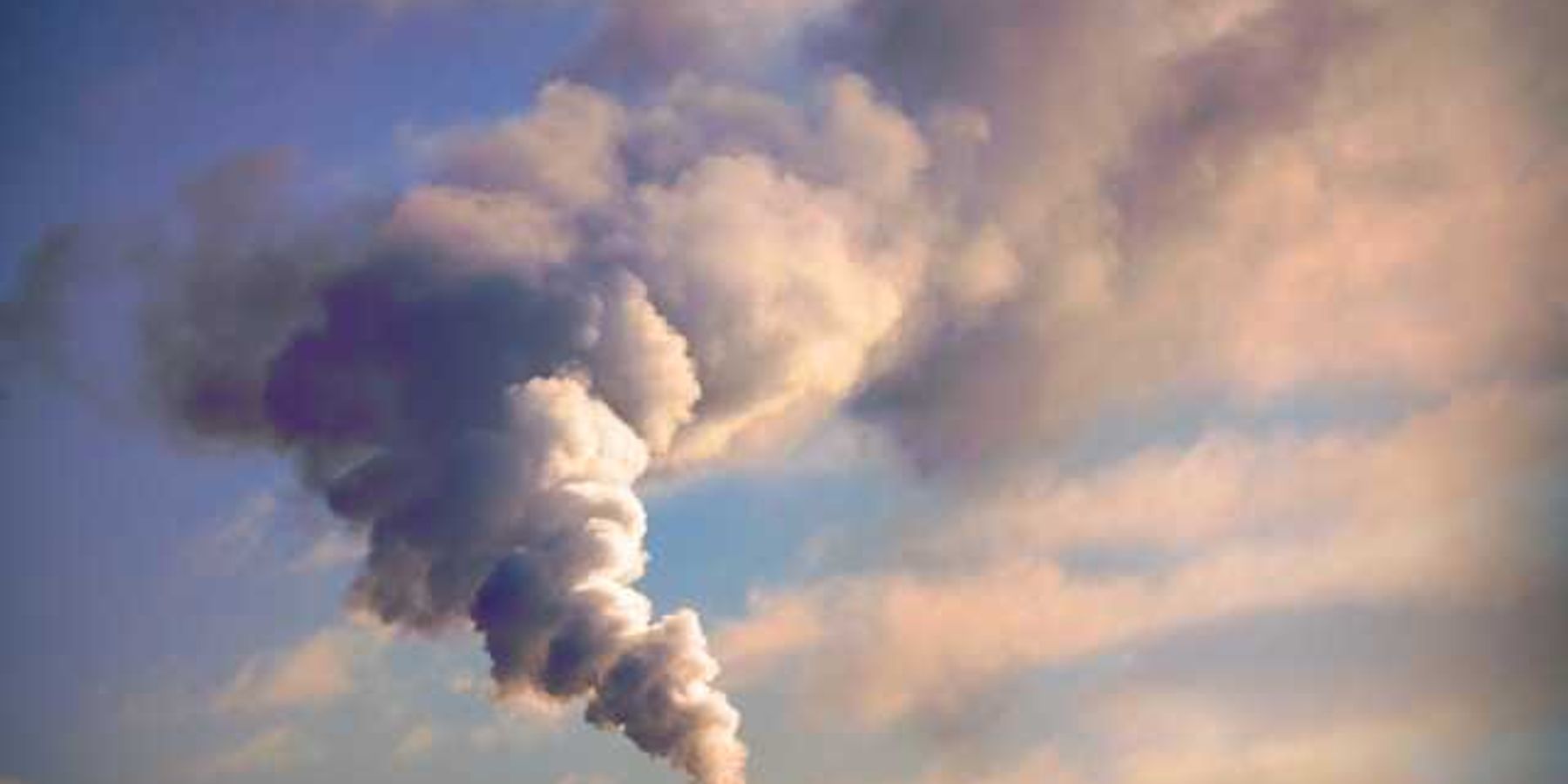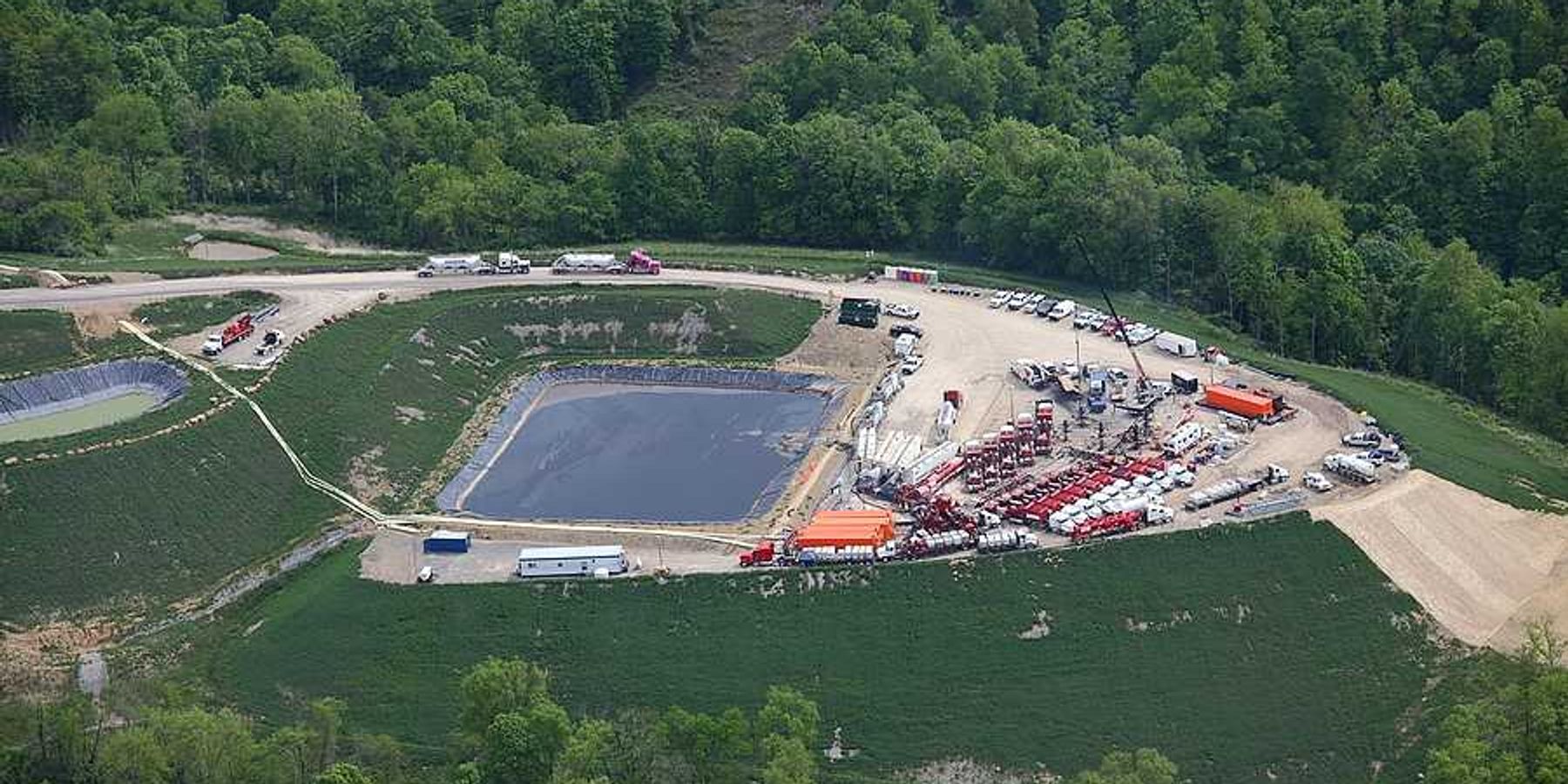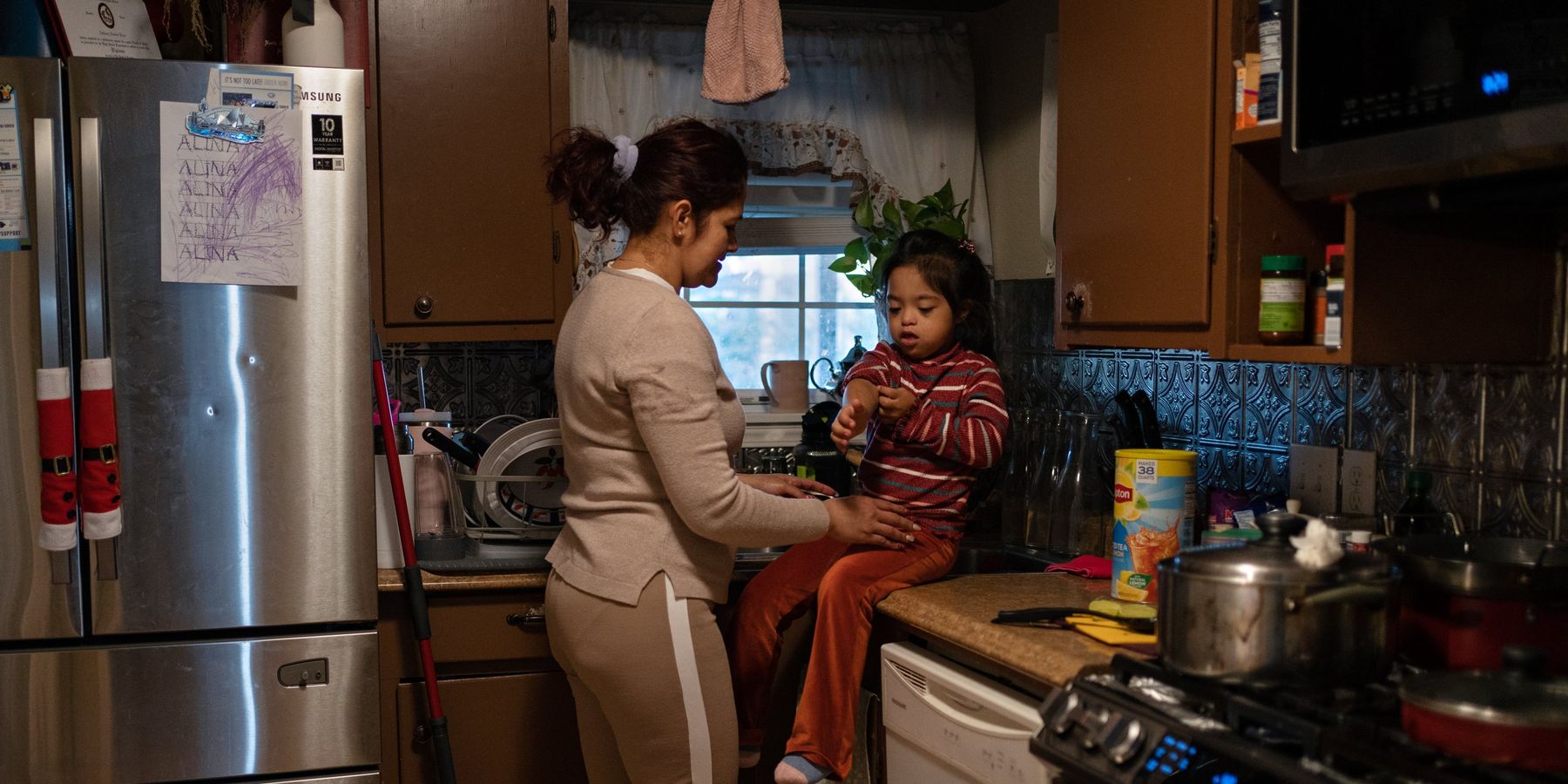
Toxic air lingers in Texas Latino community, revealing failures in state’s air monitoring system
Public data from a network of state air monitors around the Houston Ship Channel is hard to interpret and is often inadequate, leaving Latino-majority neighborhoods like Cloverleaf unaware of whether the air they breathe is safe.
This project was created through the Altavoz Lab Environmental Fellowship in partnership with Environmental Health Sciences and received additional funding from the Pulitzer Center. It was co-published by The Texas Tribune, Environmental Health News and palabra.
To read a version of this story in Spanish click here. Haz clic aquí para leer este reportaje en español.
Listen to this story:
CLOVERLEAF — On a hot, humid October day, Cristina Lazo readies her youngest daughter for a bike ride and whispers in Spanish, I pray to God nothing happens to you.
Lazo, who wears a Rebelde band T-shirt and biker shorts, takes Alina, an energetic 7-year-old, outdoors for short periods because it only takes a few minutes before Alina’s eyes get red and her coughing starts.
“ Vámonos,” Lazo yells, lengthening the last syllabus as she begins pedaling through the streets of Cloverleaf, an unincorporated area about 15 miles east of downtown Houston. Alina starts coughing immediately.
Lazo, a 42-year-old mother of six, knows that tonight she’ll rub Vick’s Vaporub on her daughter’s chest, and in the morning Alina will still wake up with congestion and what Lazo calls "itchy spider webs” in her eyes.
Even though doctors haven’t been able to pinpoint what causes Alina’s symptoms, Lazo suspects the air outside, which she said often reeks of chemicals — she calls it a “poison-like smell.” So she limits Alina’s outdoor activities and buys an antibiotic ointment at a Salvadoran pharmacy for her daughter’s itchy eyes.
Cloverleaf, where 79.4% of its 24,100 residents are Hispanic, is one of a string of communities that sits in the shadow of the 52-mile-long Houston Ship Channel, one of the world’s largest petrochemical complexes where more than 200 facilities process fossil fuels into plastics, fertilizers and pesticides.
Lazo can’t see the smokestacks from her home, but most days they release dark clouds of chemicals that permeate Cloverleaf and nearby communities like Channelview, Galena Park and Pasadena.
The emissions include particulate matter — microscopic particles that can penetrate deep into the lungs and cause irregular heartbeats, aggravate asthma and other respiratory ailments — which some scientists call the deadliest form of air pollution. A recent air quality analysis by Air Alliance Houston using industry emissions data submitted to the state found a higher annual average concentration of particulate matter the closer people live to the Ship Channel.
The plants also spew cancer-causing chemicals like benzene that can irritate the throat and eyes when large amounts are inhaled.
In Cloverleaf and nearby communities, locals say the air often smells like rotten eggs, nail polish or burning tires. Many residents said they suffer from respiratory problems, asthma and skin ailments, and they wonder if the air they’re breathing is the culprit.
Yet information about what they're breathing every day is hard to find, despite the presence of 23 state air monitoring sites near the Houston Ship Channel.
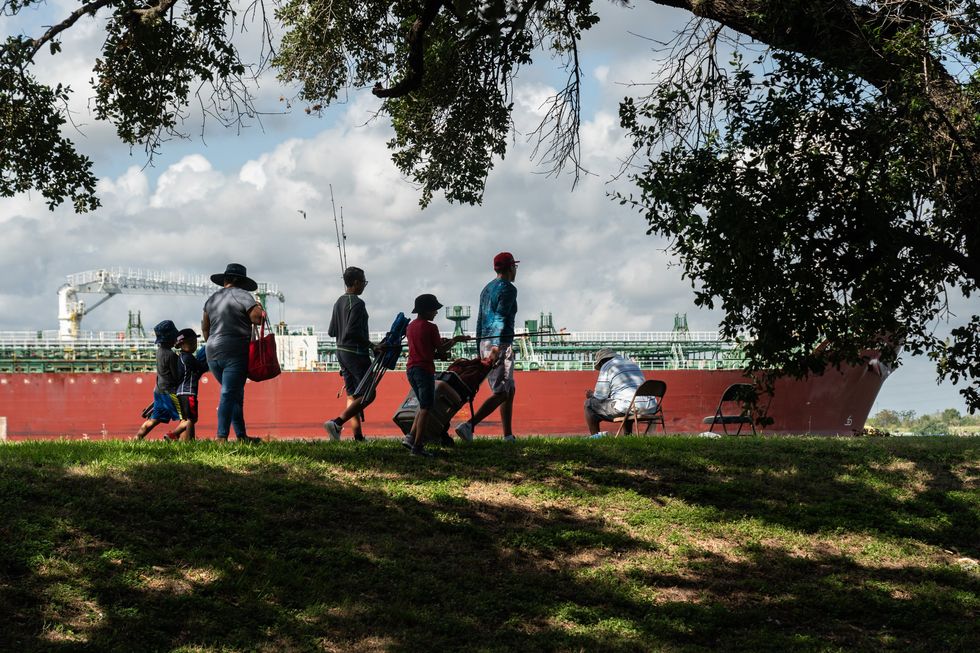
People walk through San Jacinto Park as a tanker ship passes through the Houston Ship Channel in La Porte. Thousands of families live and play near the world’s largest petrochemical complex.
Credit: Go Nakamura for The Texas Tribune
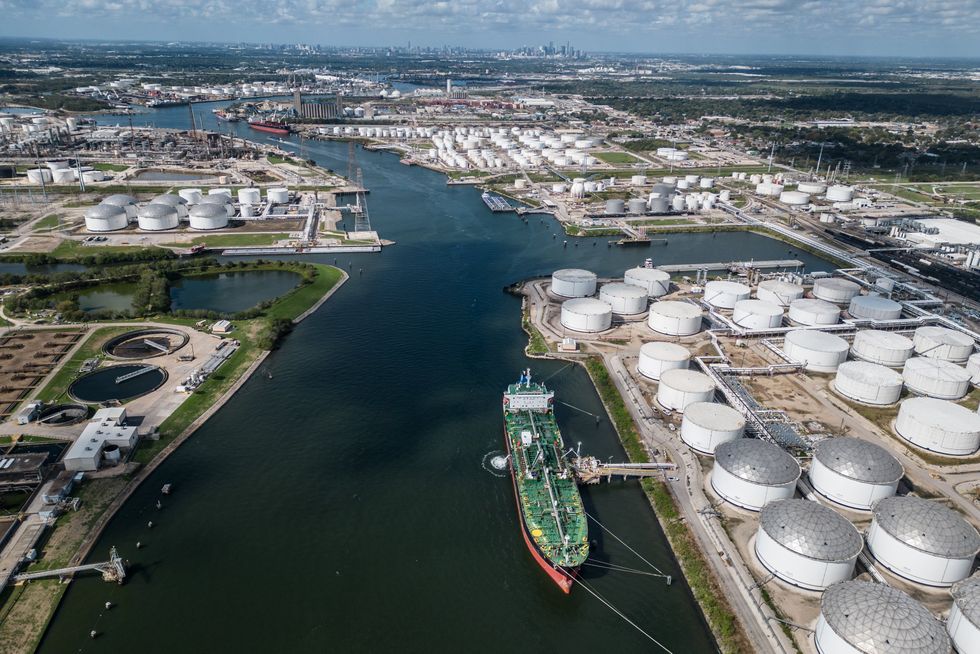
Hundreds of chemical plants, refineries and terminals line the Ship Channel as seen in Pasadena, less than 15 miles southeast of downtown Houston. According to a report by Amnesty International, people living near the Houston Ship Channel, often low-income communities of color, have lower life expectancies than those living in wealthier, mostly white neighborhoods further from the industrial area.
Credit: Go Nakamura for The Texas Tribune
The Texas Commission on Environmental Quality’s decades-old air monitoring system does not measure many of the known pollutants coming from the nearby petrochemical plants. For example, the closest monitor to Cloverleaf does not measure particulate matter or sulfur dioxide — two of the six health-threatening airborne pollutants that the U.S. Environmental Protection Agency (EPA) has strictly limited to protect human health.
Jeff Robinson, an EPA official who manages the air monitoring division, said federal law does not require states to measure all six criteria pollutants at every air monitoring site.
Each pollutant has a set of rules that helps states determine how many monitors they need to measure its presence in an area. The rules include installing air monitors based on population numbers and the number of emission sources in a region.
Robinson added that “there's nothing that precludes a state from over monitoring.”
The information that the TCEQ’s air monitoring system does collect is difficult for the average resident to understand and usually only in English. That’s a challenge for people in places like Cloverleaf, where more than 71% of residents speak Spanish at home.
“There's nothing that precludes a state from over monitoring.” - Jeff Robinson, EPA official
Federal law doesn’t say how the information should be presented to the public, Robinson said.
Dozens of residents told The Texas Tribune/Environmental Health News/Altavoz Lab they did not know that the state had an air monitoring network.
Deysy Canales, 34, a mother of three who likes to spend time outdoors relaxing in her hammock or tending to her aloe vera plants, has battled chronic asthma since moving to Cloverleaf. She was surprised to hear about the state air monitors.
"It is important for [TCEQ] to inform the population about air quality and pollution so that asthmatic people like me can take better care of ourselves," she said in Spanish.
Patricia Prado, a 43-year-old Cloverleaf resident, has asthma and regularly experiences congestion and severe allergies. Her daughter Jocelyn Prado, 21, said she deals with throbbing, uncontrollable migraines, allergies and a persistent skin condition that makes her itchy.
They also didn’t know about the state air monitoring system. Jocelyn Prado said it "was shocking to me and to my mom. It's something that we never knew. The government doesn't tell us."
She added that air quality information would be useful when she sees petrochemical facilities' towers burning like enormous candles from her home.
“With that information, I feel like we could put on a mask, limit the time of being outside or just be aware,” she said.
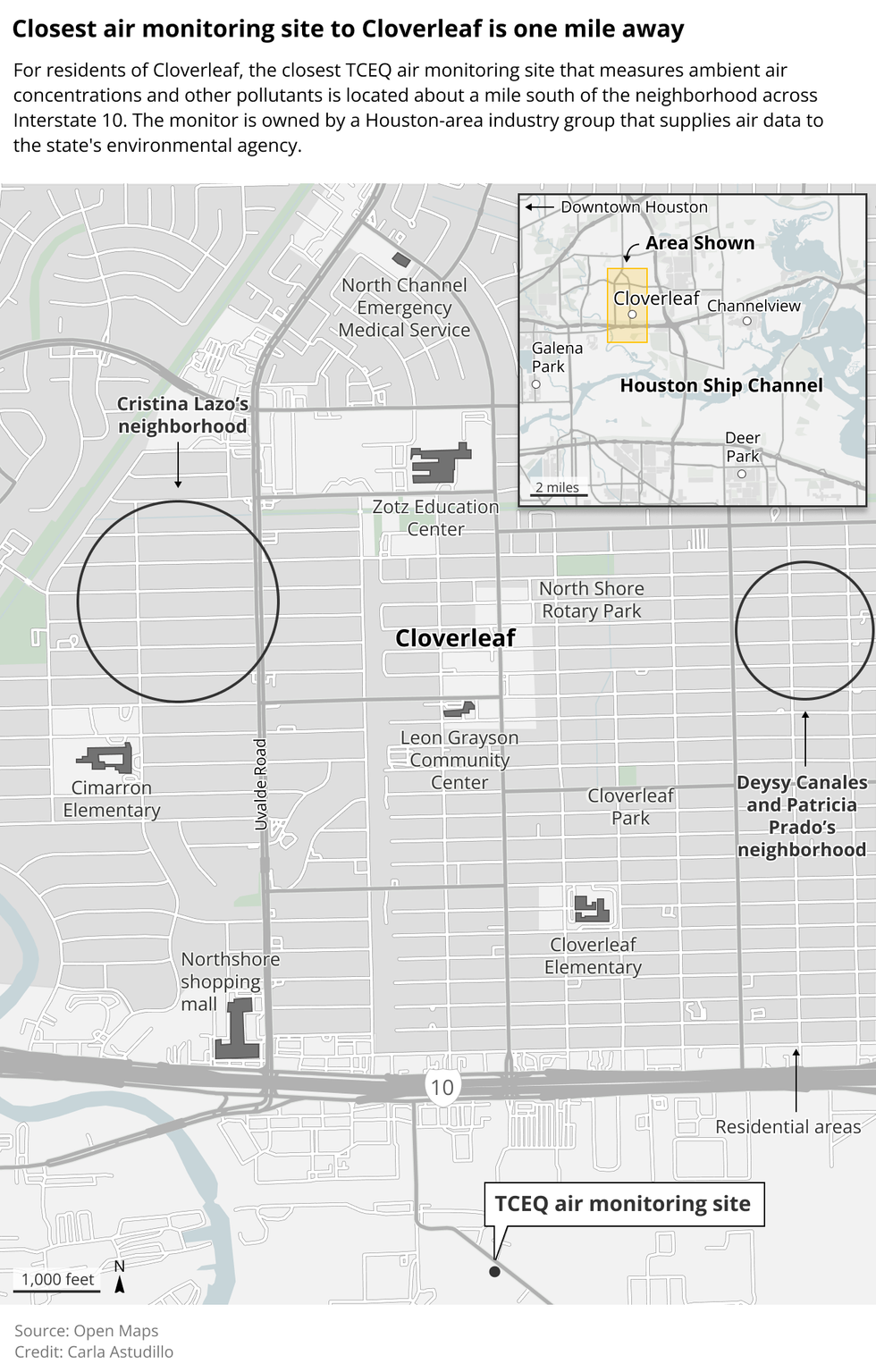
While TCEQ said it has worked to make their air quality data easy to understand, locals and advocates say it’s not enough. Data on the TCEQ’s public website does not connect the dots for residents, offering no explanation or context to help users decipher what they’re seeing.
“There is a need for broader ways of communicating what this means for health. What does this level mean?” said Natalie Johnson, an environmental toxicologist at the Texas A&M University School of Public Health. “That currently is hard to interpret.”
Erandi Treviño, who lives in a neighborhood 19 miles south of Cloverleaf and is a coalition organizer for the environmental nonprofit Healthy Port Communities Coalition, said the air monitoring network is essentially worthless for people in her community.
“A big problem still with TCEQ is that the information they do share is too dense and difficult to understand,” Treviño said. “They need to communicate in a clear way and with simple language that can be understood by the average person in the community.”
Victoria Cann, a spokesperson for the TCEQ, said in an email that the air monitoring network’s primary intent is to use the data collected to determine compliance with federal regulations, forecast air quality conditions, evaluate air pollution trends and study air quality’s impact to human health to inform regulatory decisions.
In response to critiques from advocates and researchers, Cann said in an email that the public can use information from the TCEQ air monitors “to assist them in making decisions about their personal exposure to current air quality conditions in their area” and added that the agency has improved accessibility throughout the years. Recently, TCEQ launched a dashboard that shows air pollution levels with a speedometer-style graphic, a tool Cann said the agency plans to further enhance.
“A big problem still with TCEQ is that the information they do share is too dense and difficult to understand." - Erandi Treviño, Healthy Port Communities Coalition
However, the state network’s blind spots were exposed in a yearlong study funded by EPA in 2021, when the Houston Health Department investigated air quality in Cloverleaf, Channelview and Galena Park and found high concentrations of formaldehyde, a colorless, flammable gas generated by plastics manufacturing that can irritate the skin, throat, lungs and eyes; repeated exposure can lead to cancer.
In Cloverleaf, the department analyzed air data from 2019 to 2020 and detected formaldehyde levels more than 13 times the EPA’s chronic health screening level, a limit that suggests long-term exposure to the substance may pose health risks. In Galena Park, the level was seven times higher, while in Channelview it was five times higher.
The study’s authors asked TCEQ to tighten its rules to reduce emissions of volatile organic compounds and ramp up monitoring of formaldehyde levels. At the time, only two air monitors near the Ship Channel, in Galena Park and Deer Park, measured formaldehyde. Three years later, Cloverleaf’s air monitor still does not measure formaldehyde.
TCEQ took no action. Cann said in an email that the formaldehyde levels found in the study fell below the agency’s threshold for further investigation and those levels “are not considered to cause any adverse health effects in the population.” She added that the agency’s threshold “is based on a more recent review of the science” than the EPA’s.
Steve Smith, chairman of the Houston Regional Monitoring (HRM), a network of more than 30 petrochemical companies that own the Cloverleaf air monitor and three others in the TCEQ network, said “there's certainly room for improvement in getting the word out, sharing with people, with the communities, what resources are out there, what data is available … that has always been a struggle, in terms of trying to translate that into something that all of us can understand,” he said.

Alina Lazo plays with her parents at Peter Piper Pizza in Houston. Due to her mother’s concerns about air pollution, she keeps Alina inside as much as she can. “But obviously, I’d like for her to get out, for her to be able to enjoy nature,” she said. “She loves to go to parks.”
Credit: Danielle Villasana for The Texas Tribune
Hector Rivero, president & CEO of the Texas Chemistry Council, an industry group representing over 200 chemical manufacturing facilities, added that the industry “remains steadfast in our support for air monitoring initiatives across the state.”
Environmental organizations like Air Alliance Houston — which has installed its own air monitors in some Ship Channel neighborhoods — and Fenceline Watch worry that the lack of air quality information in other languages is preventing residents from knowing when it's safe to go outside. They added that accessible, multilingual information about air quality would help residents pressure authorities to address hazardous air quality in their communities.
Back in Cloverleaf, Lazo said air quality information has not reached her community and people are dealing with the consequences.
“Cloverleaf is not being paid attention to,” she said. “Not as deeply as [the state] should."
Dirty air, silent costs in “sacrifice zone”
A few blocks from the Lazos’ house, Canales, a petite woman with curly brown hair pulled into a ponytail and sun-kissed skin, watches her kids playing with a ball outside their mobile home, which is surrounded by a chicken wire fence.
“There’s a lot of smells here,” Canales said in Spanish. “The smells that waft are like something burning, as if they were burning plastic.”
Her husband, her son and two daughters are healthy, she said, but she is not. Since moving to Cloverleaf from Honduras, Canales said she has developed allergies, asthma and a persistent sore throat.
“In my country, I never got anything. But now that I have come to live here, in Cloverleaf, I do get sick more often and I go to the doctor for asthma attacks,” Canales said.
The attacks are like “a gut punch to the stomach,” robbing her of air, she said. She fights the symptoms with Vicks VapoRub, chamomile tea and a bunch of medications she carries everywhere in her small squared-shaped purse.
Her two daughters tend to her during the attacks. “My mother gets asthma so bad she can’t even breathe, and it makes me feel really bad and sad because she is my mother,” 10-year-old Ashley said.
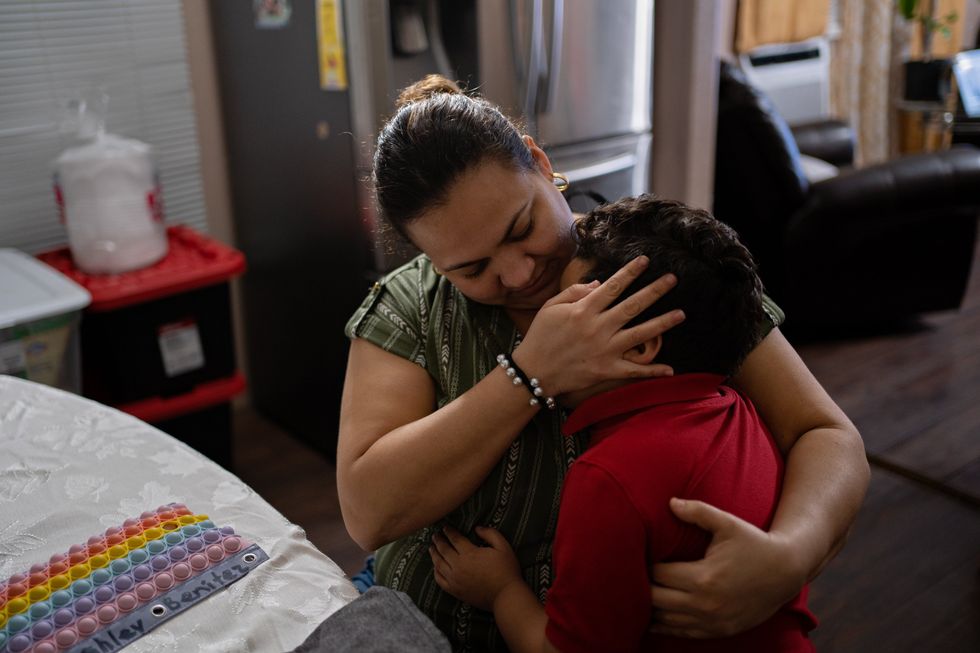
Deysy Canales kisses her 4-year-old son in the kitchen of their home. Since she moved to Cloverleaf, Canales says she is often sick, but she is grateful that her three kids remain in good health.
Danielle Villasana for The Texas Tribune
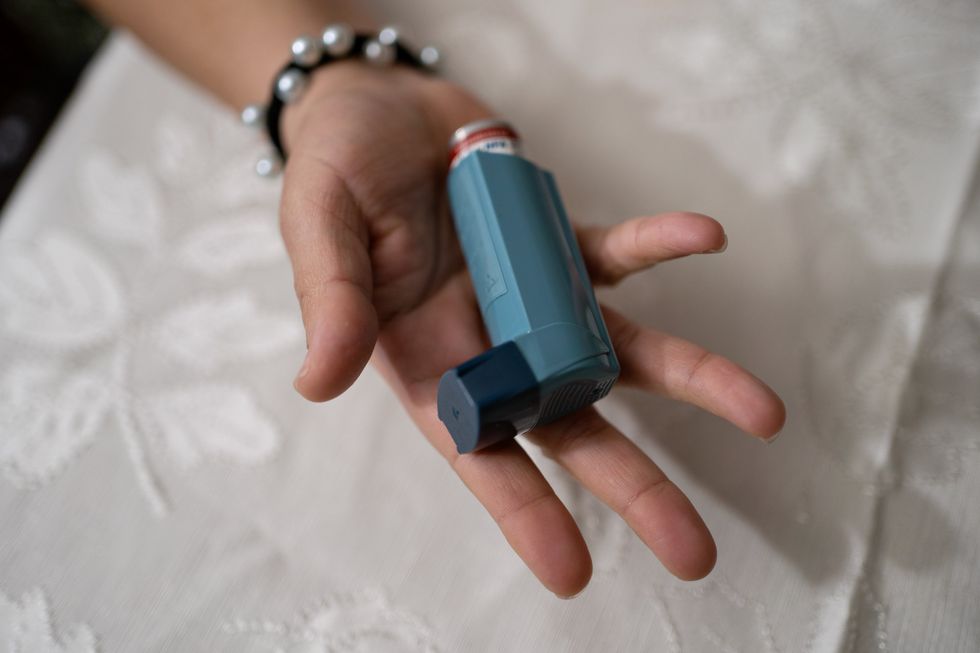
Deysy Canales carries her inhaler everywhere she goes in case of an asthma attack, which she says are frequent. “You become so tired that you can’t do normal activities,” Canales said.
Credit: Danielle Villasana for The Texas Tribune
Asthma is common in Cloverleaf: 10.5% of adults have it, compared to the national average rate of 9.7%. Children living in Harris County have an asthma rate of 8.9% — higher than the state average of 7%.
Last year, Canales was hospitalized two times in three months for asthma attacks. During the most recent one, she went to Houston Methodist Baytown Hospital, where she was seated in a wheelchair and hooked up to a steam machine to inhale medication through a mask.
“I couldn't even walk,” she recalled.
When her symptoms appear, Canales said she goes to a nearby clinic, where she typically pays less than $20 for a consultation but close to $400 for tests and medications — more than what she earns in a week at their family’s business making wooden crates to transport produce. She said she hasn’t seen an asthma specialist because she’s uninsured.
Canales is among roughly 54% of Cloverleaf residents who don't have health insurance, according to a recent Harris County study. That’s more than three times higher than the statewide uninsured rate of 16.6%.
“There’s a lot of smells here. The smells that waft are like something burning, as if they were burning plastic.” - Deysy Canales, a mother of three in Cloverleaf
Studies show that the nearly 69,800 residents of Cloverleaf and Channelview — more than a third of them children under 18 — are breathing some of the dirtiest air in the country.
According to the American Lung Association's 2023 "State of the Air" report, Harris County has an "F" grade for having unhealthy levels of particulate matter and ozone pollution, which can damage the lungs and trigger respiratory problems.
A recent report by the human rights organization Amnesty International found that people living in communities near the Houston Ship Channel, primarily low-income communities of color, have life expectancies up to 20 years shorter than wealthier, predominantly white areas just 15 miles away. Labeling the Ship Channel area a "sacrifice zone," the organization criticizes both the petrochemical industry for spewing toxic pollutants and government agencies like the TCEQ and EPA for lax enforcement of their own regulations.
Harris County also has some of the state’s highest levels of cancer. Lazo’s 87-year-old father, who has lived in Cloverleaf for more than 20 years, is in remission from liver cancer, and Lazo cares for him while her mother goes to church.
An 18-month study published in 2007 by the University of Texas School of Public Health and the Houston Health Department found that children living within two miles of the Houston Ship Channel had a 56% greater chance of being diagnosed with acute lymphocytic leukemia than children living at least 10 miles away from the Ship Channel. While the study did not directly link exposure to hazardous chemicals and increased cancer in kids, researchers suggested a second analysis.

Christopher Shackelford, a reverend at St. Andrew Catholic Church, blesses a churchgoer after mass in Channelview. Shackelford, who has severe allergies, takes medications daily to prepare himself for sermons in front of his almost 3,000 congregants. He believes pollution in the area has harmed his health and the health of those who attend his church.
Credit: Danielle Villasana for The Texas Tribune
Dr. Philip Lupo, an epidemiologist specializing in childhood cancer at Baylor College of Medicine and Texas Children's Hospital in Houston, said genetics alone can’t explain the number of child cancer cases in the Houston area.
"It's so important to consider the environment,” he said.
Despite being the nation’s largest petrochemical corridor, Lupo said there aren’t enough studies in Houston that explore possible links between petrochemical air pollution and cancer — or enough money to make them happen.
"There are plenty of lines of evidence that suggests that pediatric cancer has an environmental component. But trying to target that has been a problem," he said. "If you have a child that lives in an area that's not as polluted, their likelihood of being exposed is just less by nature."
Studies in other countries have shown that residents who live near petrochemical plants releasing hazardous chemicals and particles have an increased risk of dying from cancers of the brain, bladder and lungs, as well as leukemia and multiple myeloma.
About 5 miles from the Ship Channel in South Houston, Erandi Treviño recalls the first time she heard about the 2007 UT leukemia study. She was a fifth grader living in Pasadena and she said hearing about how pollution could impact health led her to environmental advocacy.
Three years ago, she began working with EcoMadres, a Latina-led group that’s part of the national environmental nonprofit Moms Clean Air Force, which focuses on protecting children from air pollution. That led to her current job with the Healthy Port Communities Coalition, which helps teach communities about air quality and how to advocate for cleaner air.
The 32-year-old struggles with fibromyalgia, a muscle disorder that causes pain and fatigue. Studies show that people with low-level chemical intolerance are more susceptible to chronic fatigue. Treviño said her body has been working overtime since she was a kid because of the polluted air she has inhaled for decades.
“Kids can’t play outside if it smells bad. They can't be children,” Treviño said. “The physical, mental and neurological effect on the bodies of these children will follow them throughout their lives, when they are older.”
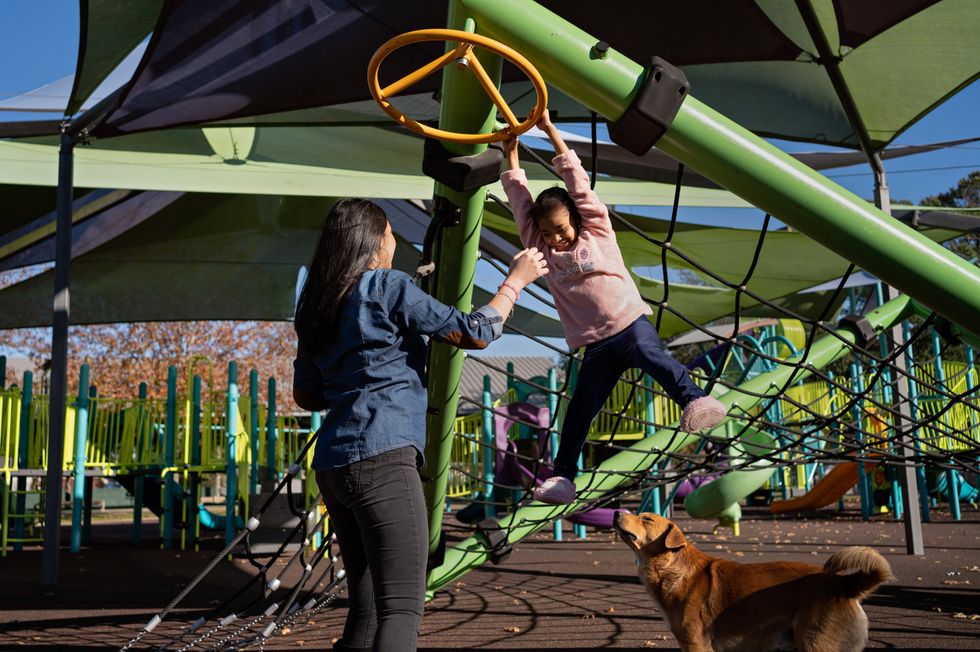
Heidy Garcia plays with Tiana Cruz at the North Shore Rotary Park in Cloverleaf. The small parks nestled in the neighborhood are some of the community’s few gathering spots.
Credit: Danielle Villasana for The Texas Tribune
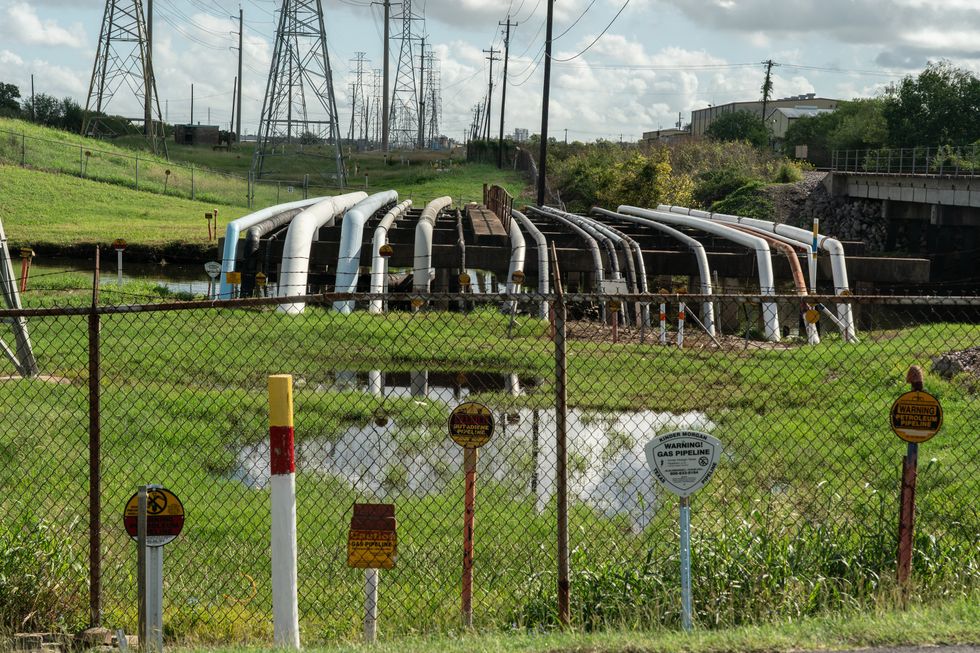
Gas pipelines near the Houston Ship Channel in Pasadena. In nearby communities, locals say the air often smells like rotten eggs, nail polish or burning tires.
Credit: Go Nakamura for The Texas Tribune
State’s air monitoring gaps
In January 2004, a crowd of several thousand at Hermann Park's Miller Outdoor Theatre saw Bill White become Houston's new mayor. In his inaugural speech, White said he would improve the city’s air quality by addressing chronic problems such as ozone and benzene pollution.
“In Texas, we believe in property rights and nobody owns the air except the public. Nobody has a right to chemically alter it or to hurt somebody else, period. End of story,” White said in his slow, husky voice.
Air pollution had become so bad in the city — particularly around the fast-growing industrial zone along the Ship Channel — and accurate, understandable air quality information was so scarce that resident-led groups began constructing an easy-to-use air sampling device inspired by a California environmental engineering firm’s design that let residents capture air samples using pickle jars and plastic paint buckets.
The Houston Chronicle called them “a team of modern-day Nancy Drews” who recorded odors from nearby chemical plants on their kitchen calendars, writing smells like "turnip" or "nail polish" next to doctor appointments and church functions.
In 2004, White appeared before TCEQ commissioners and criticized the agency for the lack of real-time air quality data on its website.
The extent of the industrial pollution in the area was underscored in 2005 when a five-part series in the Houston Chronicle, "In Harm's Way," found elevated levels of 1,3-butadiene and benzene in four East Houston communities, sparking public debate about the city’s air pollution problems.
Following the newspaper’s investigation, White took legal action against Texas Petrochemicals Company, a Houston-based company with a history of violations that was believed to be the source of elevated hazardous air pollutants in East Houston. The company agreed to sign a pollution reduction agreement for 1,3 butadiene and install a fenceline monitoring system. After the agreement, the plant reduced butadiene emissions by 58%, according to reports.
In 2006, a TCEQ report reinforced what the newspaper’s investigation had found — historically high concentrations of benzene and 1,3-butadiene at monitors in Galena Park, Manchester and other communities near the Ship Channel.
Decades before White’s crusade, Texas state was considered a pioneer in air monitoring. In January 1972, a year after the newly created EPA adopted national air quality standards under the Clean Air Act, Texas installed its first continuous air monitoring station at the Jefferson County Airport in Nederland, which measured ozone on a near real-time basis. Later that year, the state added another one in southeast Houston.
“In Texas, we believe in property rights and nobody owns the air except the public. Nobody has a right to chemically alter it or to hurt somebody else, period. End of story.” - Bill White, former Houston mayor (2004-2010)
The new federal standards aimed to protect Americans’ health by setting limits on six airborne pollutants: ozone, sulfur dioxide, particulate matter, carbon monoxide, lead and nitrogen oxide.
Texas began its own monitoring network in 1974, five years before the EPA required them nationally. The Texas Air Control Board, TCEQ’s predecessor, launched a network of 214 sites with 36 continuous air samplers to measure pollution levels in Houston, Dallas, El Paso, Beaumont, San Antonio, Corpus Christi and Austin.
Today, the Texas air monitoring network is one of the largest in the country, with 228 air monitoring stations across the state, including about 47 in the Houston area. TCEQ said in an email that air monitoring stations are strategically placed across the state to assess air quality.
Four of those, including the one in Cloverleaf, are owned by Houston Regional Monitoring (HRM), a network of 30 petrochemical companies.
Smith, the HRM chairman, said that the industry-owned monitors were installed to help the industry obtain air quality information that would help them meet permit requirements and help cash-stripped TCEQ meet the need for more monitors.
The machines are expensive, some costing up to $500,000. And not all Texas counties have one — notably, few are located in the Permian Basin in West Texas, the nation’s biggest and most active oil-producing region — and not all measure the six pollutants targeted by the EPA, according to the TCEQ.
On the TCEQ’s website, a daily air forecast report shows ozone and particulate matter levels in Texas' metropolitan areas using a color-coded system — green, yellow and red. The agency’s geospatial database shows real-time data on the amount of pollutants in the air when users select an air monitor location.
But residents and environmental advocates say the state’s air information is hard for the average resident to interpret. The data is organized in spreadsheets and colorful maps — a sea of numbers with no context.

Ebrahim Eslami, a research scientist at Houston Advanced Research Center (HARC), points to air quality charts at his office in Spring, north of Houston. “It is really confusing,” Eslami said about navigating the Texas Commission on Environmental Quality’s website. “It’s a very, very tedious task even for me.”
Credit: Go Nakamura for The Texas Tribune
“Not even my wife, who has been exposed to several years of nerdy air quality talk during the last 10-11 years, knows how to read the quality data,” Ebrahim Eslami, a research scientist specializing in air quality at Houston Advanced Research Center, an independent research hub, said as he pointed to a number on TCEQ’s website. “The average person doesn’t know. There is no indication if 11 is bad or good or I don't know.”
Eslami has compared Texas’ site to neighboring Louisiana’s, which tells users whether a pollutant is measuring at higher or lower levels than federal health limits on the same page as their air quality readings.
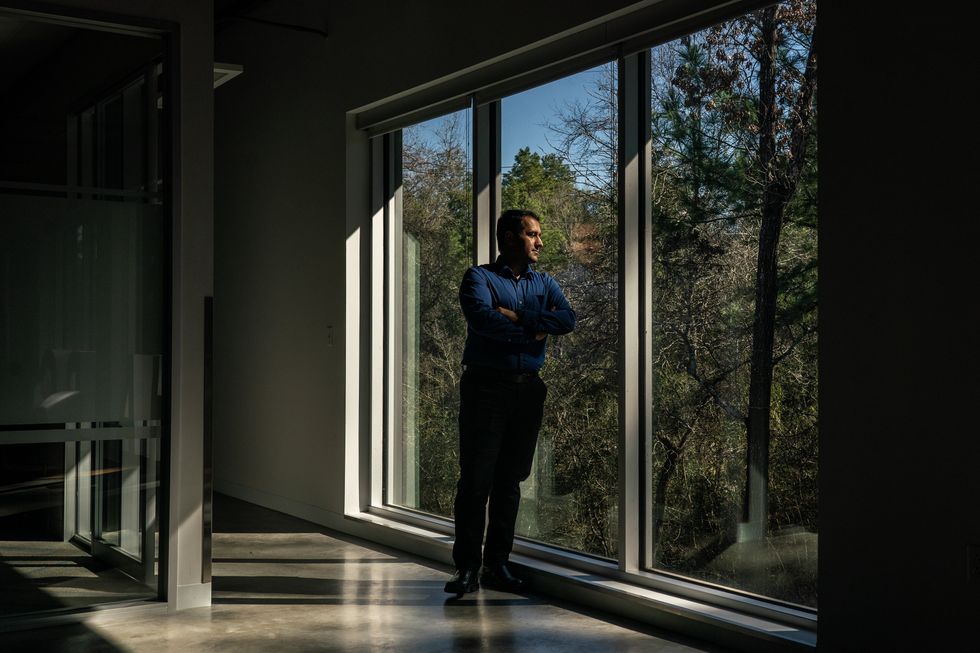
Ebrahim Eslami said the local governments and environmental organizations are trying hard to cover a lot of gaps in air monitoring.
Credit: Go Nakamura for The Texas Tribune
In Cloverleaf, Lazo's home buzzed with energy on a December afternoon — all her children had gathered for the holidays and she’d put a towering silver and blue frosted Christmas tree in the living room.
Lazo was curious about how she could check the air quality outside. With guidance, she picked up her phone and entered the TCEQ air monitoring website for the first time, looking at the Texas map with raised eyebrows.
“I just see a bunch of little squares with colors,” Lazo said in Spanish. “I won’t know what it is if [TCEQ] doesn’t explain it to me.”
Lazo clicked on her neighborhood’s air monitor, then on a list of contaminants: benzene, 1,3 butadiene, ozone, toluene. The levels appeared on a graphic that looks like a speedometer, but they didn’t indicate whether those levels were bad or good.
“I don’t understand this at all,” Lazo said.
She said she has the right to this information and wishes it was presented like a daily weather report, something everyone can understand, “to be able to enjoy nature more with my loved ones. To be able to be in the fresh outdoors.”

Alina Lazo watches a video while her mother Cristina Lazo looks out her front door while talking on the phone at their home in Cloverleaf. Sometimes the wind brings “smells like chemicals” and “you can see the dust in the house and in the cars,” Lazo said.
Credit: Danielle Villasana for The Texas Tribune
The state’s air monitoring system has also failed Texans when they need pollution information the most — during industrial accidents near their homes. According to data compiled by the Coalition to Prevent Chemical Disasters, a group of environmental justice organizations, in 2023 Texas recorded 90 chemical incidents, including fires, explosions or toxic releases — the most of any state.
On March 17, 2019, towering flames and black smoke billowed from Intercontinental Terminals Company, a chemical tank farm in Deer Park, next to the Ship Channel. As firefighters struggled to extinguish the growing chemical fire, nearby residents wondered if it was safe to go outside.
City officials advised Deer Park residents to shelter indoors twice: for 18 hours immediately after the fire started and again three days later.
Harris County Commissioner Adrian Garcia wanted data from the state that could help answer residents’ questions. But the Deer Park air monitor closest to the fire, which TCEQ calls “one of the most comprehensive air monitoring stations in the TCEQ network,” did not gather data for cancer-causing chemicals during the first two days of the disaster because it was malfunctioning.
“Not even my wife, who has been exposed to several years of nerdy air quality talk during the last 10-11 years, knows how to read the quality data.” - Ebrahim Eslami, a research scientist at Houston Advanced Research Center
Cann, the TCEQ spokesperson, said a part of the monitor that reads and evaluates air quality was causing a series of data gaps and that system “required repair and quality control checks and calibrations to be performed.”
Garcia said the state left the county ill-prepared during a crisis and county officials didn’t feel they were being told everything they needed to know about the severity of the air pollution.
“I have absolutely zero confidence in TCEQ, regretfully,” Garcia said. “It's just been indicative that TCEQ tends to look out for industry more than they tend to look out for the community.”
About 11 hours after the fire erupted, TCEQ investigators began using handheld monitors to measure volatile organic compounds, hydrogen sulfide and carbon monoxide. In a timeline of events the agency submitted to state lawmakers a month later, investigators noted “slight odors, however, no readings of concern are detected.”
Five days later, EPA dispatched a mobile laboratory that roamed the area for the next two months. A 2023 Texas Tribune investigation found that dangerous levels of benzene remained in the air for weeks after public health measures were lifted, according to data captured from the mobile units.
Benzene is known to cause cancer after repeated exposure and can affect the central nervous system when inhaled in large quantities over a short period.
Hundreds of people went to mobile health clinics in Deer Park provided by the county, reporting symptoms including dizziness, a rapid heart rate and headaches — even after the fire was extinguished after four days.
On March 31, two weeks after the fire began, TCEQ and EPA inspectors with handheld devices recorded elevated benzene concentrations drifting through neighborhoods and near an elementary school.
The public was told nothing about the spikes until the next morning.
“Failures like that cannot happen during times of environmental disasters,” Air Alliance Houston, a local environmental group, wrote to TCEQ when ITC applied to renew its operating permit. “Community members must have a full understanding of what pollutants are in the atmosphere and the effects they can have on them.”
Residents turn to community monitoring
In Galena Park, Juan Flores, 46, said two major life events galvanized him to become an activist: his father died of a heart attack after years of working at a petrochemical facility and suffering from respiratory problems, and his only daughter, Dominique Soleil Flores, was born with teratoma, a rare type of cancerous tumor located around one of her kidneys.
Dominique had to go through rounds of chemotherapy and surgeries to remove the tumor. Today, the 8-year-old is cancer free, but Flores still worries about his family’s health — and the effects of living near petrochemical plants.
Flores, wearing a black polo with a gold chain around his neck, said he doesn’t trust government agencies to protect people’s health. When he’s called TCEQ or the city about strong chemical smells outside, he said it takes hours or days for anyone to respond — and by then the smell is usually gone.
Ten years ago, he joined Air Alliance Houston as an organizer teaching local residents about air quality. He and other organizers decided to install a community air monitoring network after the ITC fire, frustrated that TCEQ had not made air monitoring information readily available and accessible to the public.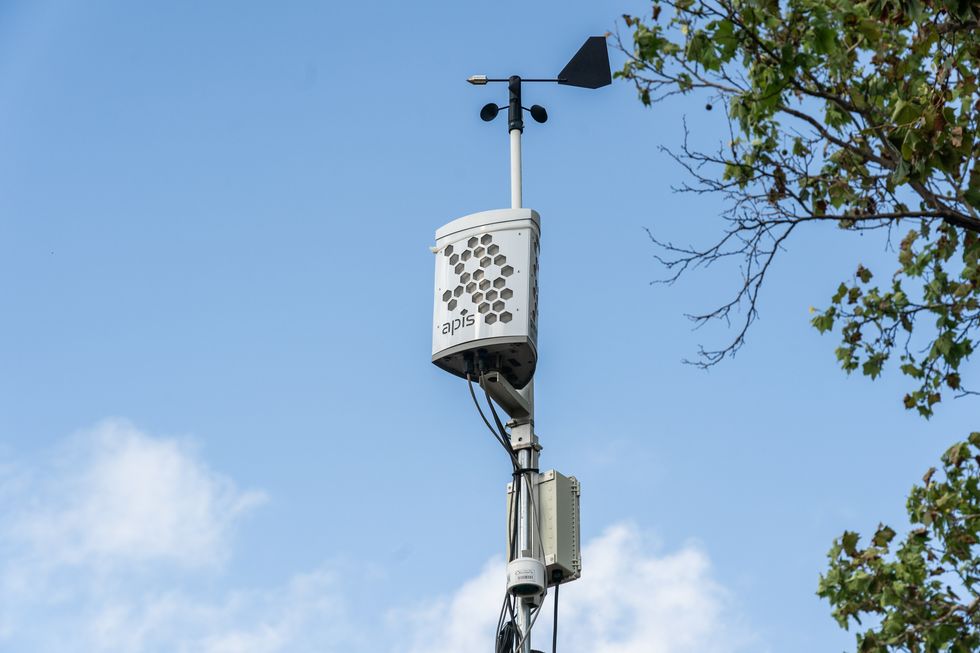
An air quality monitor in a neighborhood in Galena Park. Organizers at Air Alliance Houston worked to install their own community air monitoring network because of frustrations with the public data provided by the Texas Commission on Environmental Quality’s network.
Credit: Go Nakamura for The Texas Tribune
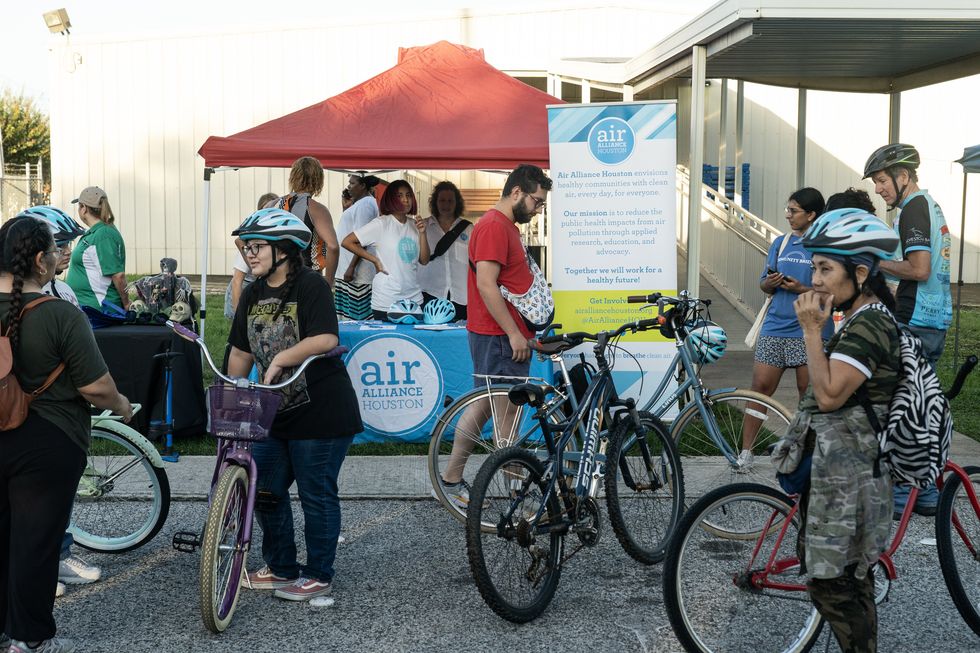
Community members prepare for a bike ride, organized by Air Alliance Houston, in Galena Park. The event is part of several educational tours to teach people about air pollution in the area.
Go Nakamura for The Texas Tribune
Flores and others asked homeowners, businesses, and churches in Galena Park if they could install monitors to measure particulate matter. The first was installed in 2020 and since then the group has installed nearly 30 in Galena Park, Channelview and other communities near the Ship Channel, spending about $300 on monitors that measure particulate matter and $11,000 on those that measure volatile organic compounds in the air, as well as nitrogen oxide and ozone.
Cloverleaf could be next.
“There's a big need in Cloverleaf to organize,” said Flores, who now works as the organization's community air monitoring program manager. “That community has been kind of neglected for years.”
The group posts the monitors’ data online using a color-coded system: green for good air quality, yellow for moderate — meaning it may be a concern for people with respiratory conditions — and red for very unhealthy.
“Education is the key,” Flores said. “They know there's a refinery there, but they don't know what it does. And they don't know what the health effects are.”
From April to December 2022, the organization's Galena Park air monitors recorded nitrogen dioxide levels more than 3,000 times above the EPA’s threshold for human safety. Nitrogen oxide can cause inflammation and damage to the respiratory system. The monitors also recorded ozone levels above the EPA’s ozone threshold more than 850 times.
“We definitely see red [high spikes] happening a lot,” said Anthony D’Souza, who works with Flores at Air Alliance Houston as a research and policy coordinator.
Flores leads residents and journalists on “toxic tours” in his pickup truck, driving through neighborhood streets where houses sit across a fence from towering refineries.
Last year, he led a tour where residents dressed up in their Halloween costumes and rode bikes through Galena Park and Jacinto City, visiting air monitors to learn about air pollution.
“[Air quality] is a hard subject,” Flores said. “When you talk to somebody about pollution, you're talking about ozone, you're talking about chemicals, people don't understand.”
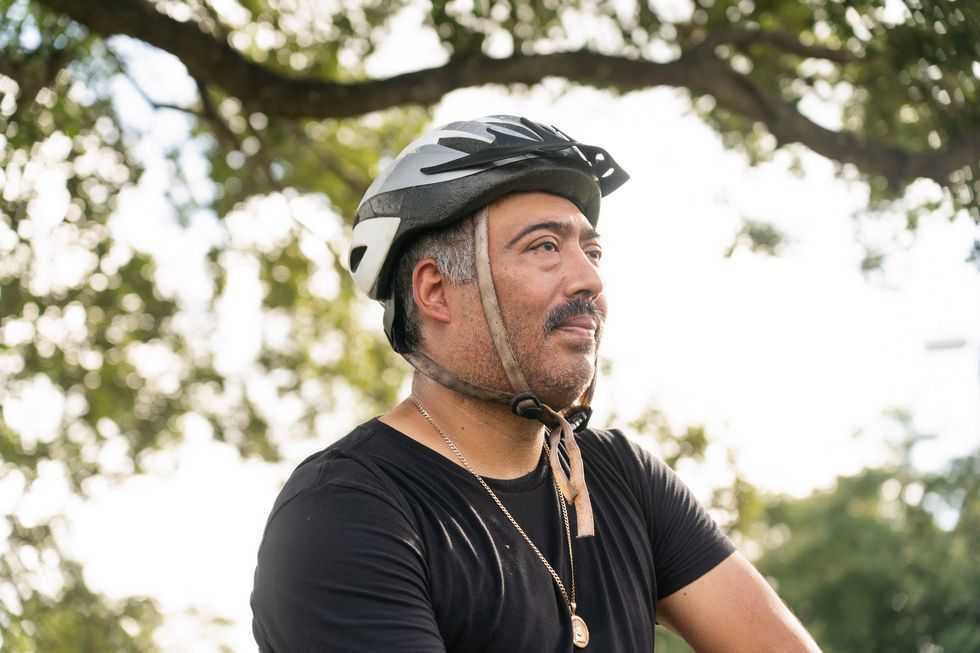
Juan Flores’ only daughter was born with a rare cancerous tumor, an event that helped motivate him to become a community organizer. Now, as a program manager with Air Alliance Houston, Flores works with residents to teach them about air pollution.
Go Nakamura for The Texas Tribune
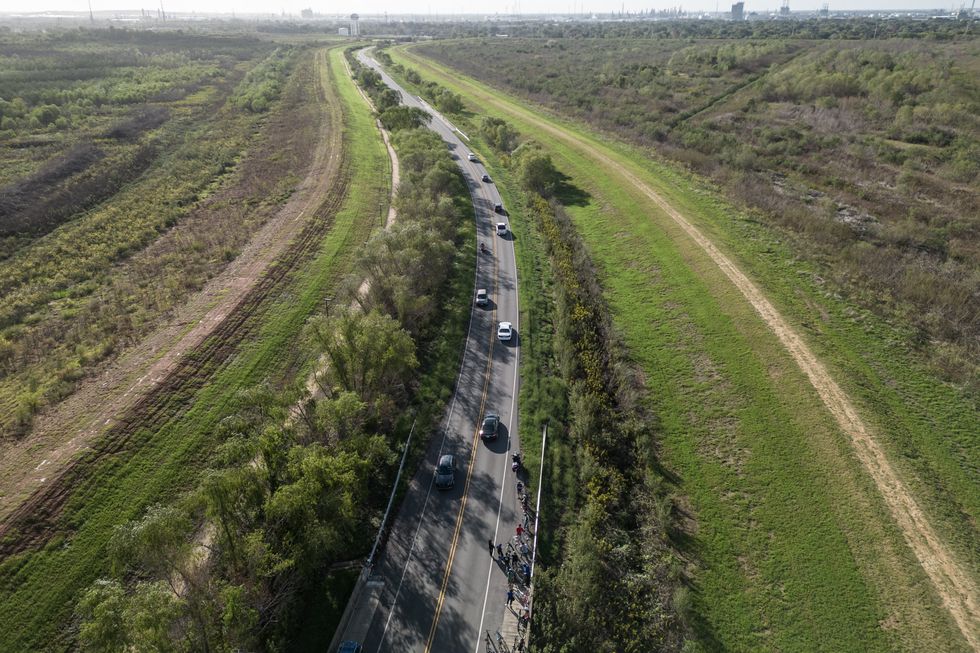
Participants of the bike ride make a stop on their tour at landfills created from dirt dredged during a ship channel expansion in the petrochemical corridor. There have been concerns about possible contaminants in the soil.
Go Nakamura for The Texas Tribune
Flores said the air data they collect is empowering, validating the concerns of many in his community. For example, at permit hearings where TCEQ seeks public comment on a company’s permit application, they can provide the number of times the community monitors have recorded red alerts and whether those correlated with the days they’ve felt sick.
Before, Flores said, they could only talk about their headaches, dizziness or shortness of breath. Now they can back up what they’re saying with numbers — although TCEQ dismisses their data because it doesn’t come from the state’s air monitors.
“It’s such an interesting thing to actually see data and to see the numbers, because it was always our word against [TCEQ],” Flores said. “Then we built this new air monitoring network, now we have our proof.”
Reporting team
Alejandra Martinez joined The Texas Tribune in the fall of 2022 as an environmental reporter. She’s covered the impacts of petrochemical facilities on Black and brown communities, including investigating a chemical fire at an industrial facility. Additionally, she has explored topics related to climate change, such as the health effects of extreme heat and how long periods of drought affect water resources in Texas. Alejandra was previously an accountability reporter at KERA, where she began as a Report for America corps member and then covered Dallas City Hall. Before that, she worked as an associate producer at WLRN, South Florida’s public radio station. Alejandra studied journalism at the University of Texas at Austin, and interned at KUT and NPR's Latino USA. She's a native of Houston and speaks fluent Spanish.
Wendy Selene Pérez is a freelance journalist with a two-decade career spanning various media outlets in Mexico, Argentina, and the United States. Her work focuses on social justice, victims of violence, government accountability, transparency, and immigration. Wendy’s articles have been featured in El País, Gatopardo, Proceso, The Baffler, Vice, and Al Día Dallas/The Dallas Morning News. She has held positions such as bureau chief of CNN Mexico, editor of Domingo magazine (El Universal), and multimedia editor of Clarin.com. Previously, she served as the chief multimedia editor of the newspaper Mural (Grupo Reforma). Wendy holds a Master’s Degree in Journalism from Diario Clarín-Universidad de San Andrés-Columbia University, with her thesis titled “La Tierra de las Fosas,” a data-driven journalistic investigation. She has been honored with the National Journalism Awards in Mexico (2019, 2022), the Walter Reuter German Journalism Award (2020), the Breach-Valdez Human Rights Award (2022, 2023), the Texas APME 2021 News Spanish-Language award, the ICFJ’s COVID-19 reporting story contest, and received an honorable mention in the Latin American Investigative Journalism Award (COLPIN, 2022).
Danielle Villasana is a photojournalist based in her hometown of Houston, Texas, focusing on human rights, gender, displacement, and health throughout the Americas. She’s the 2022 Alexia Grant Professional Winner, a National Geographic Explorer, Magnum Foundation awardee, Women Photograph grantee, IWMF fellow, and alumna of the Eddie Adams Workshop. With a strong belief in photography paired with education and community, she’s a co-founder of We, Women, and an Authority Collective board member, on The Everyday Projects’ Community Team, and a Photo Bill of Rights co-author. She’s also a member of Women Photograph, Diversify Photo, and Ayün Fotógrafas.
Go Nakamura began his photography journey as a wedding photographer in Honolulu, Hawaii in 2006. In 2009, he relocated to New York City and transitioned into news/documentary photography, freelancing with the New York Daily News in 2015. Since then, he has broadened his scope, freelancing for renowned outlets such as The New York Times, The Wall Street Journal, Thomson Reuters, Getty Images, Bloomberg Business, Texas Tribune, and Houston Chronicle.
Focused on addressing pressing social issues, Go's work aims to harness the power of visual imagery for maximum impact. His photography has garnered international acclaim, including awards such as Pictures Of The Year International (POYi) and Best Of Photojournalism (BOP). In 2021, he was part of the Getty Images team named as finalists for Feature Photography at the Pulitzer Prize.
Greta Díaz González Vázquez is an international multimedia journalist with experience reporting in Mexico and the U.S. She tells bilingual narrative stories through audio, video and photography with a focus on gender violence, science and marginalized populations. Originally from central Mexico, Greta has worked in public radio and has freelanced for nonprofit newsrooms. Her work has been recognized with numerous national and state awards in her home country.
Jimmy Evans is a documentary filmmaker and journalist as well as a graduate of the University of Florida. His films highlighting environmental issues have been featured at film festivals nationwide and on outlets such as PBS. Jimmy is currently an assistant video editor at Environmental Health News and his work focuses on environmental health stories in the Houston, Texas area.

